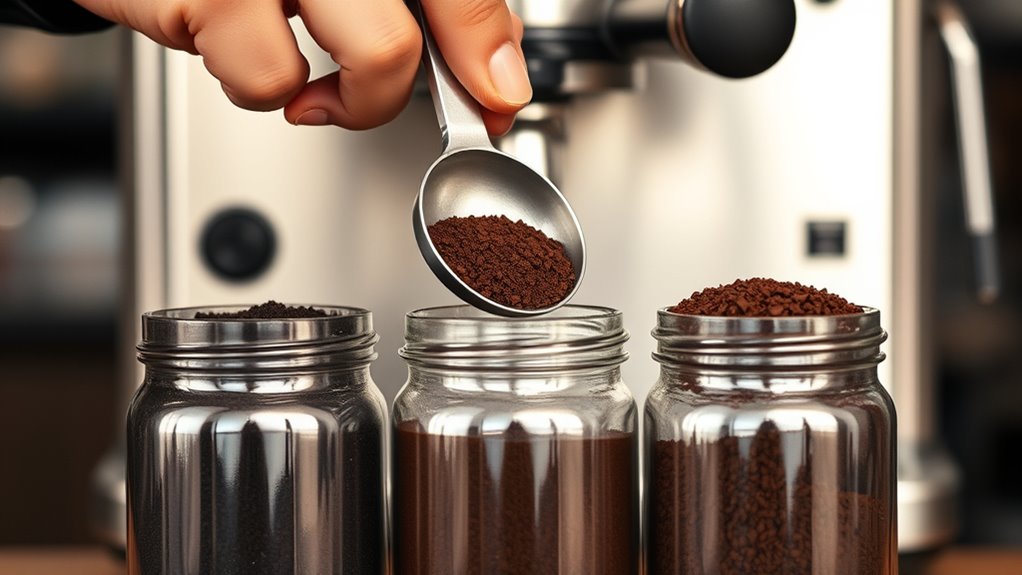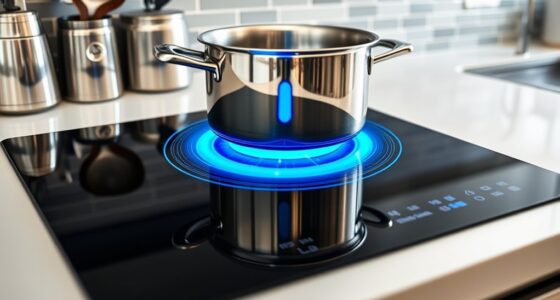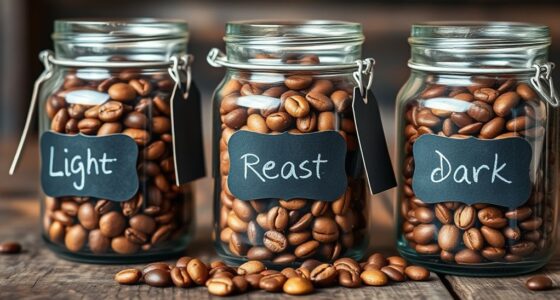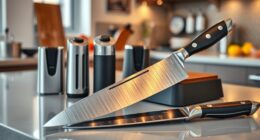Your grind size directly impacts how your coffee extracts, influencing flavor, clarity, and strength. Finer grounds increase surface area, quickening extraction and emphasizing bright, sharp flavors, while coarser grinds slow water flow, producing lighter and less bitter cups. Using the right grind for your brewing method is key—espresso needs a fine grind, French press coarser, and cold brew extra-coarse. Keep experimenting to find your perfect balance and uncover the full potential of your brew.
Key Takeaways
- Finer grinds increase surface area, leading to faster extraction and emphasizing bright, acidic flavors.
- Coarser grinds slow water flow, resulting in lighter, more delicate brews with less bitterness.
- Uniform particle size ensures balanced extraction; uneven sizes can cause over- or under-extraction.
- Adjusting grind size influences brew time, helping to correct issues like under- or over-extraction.
- Different brewing methods require specific grind sizes to optimize flavor, clarity, and overall coffee quality.
Understanding the Relationship Between Grind Size and Extraction
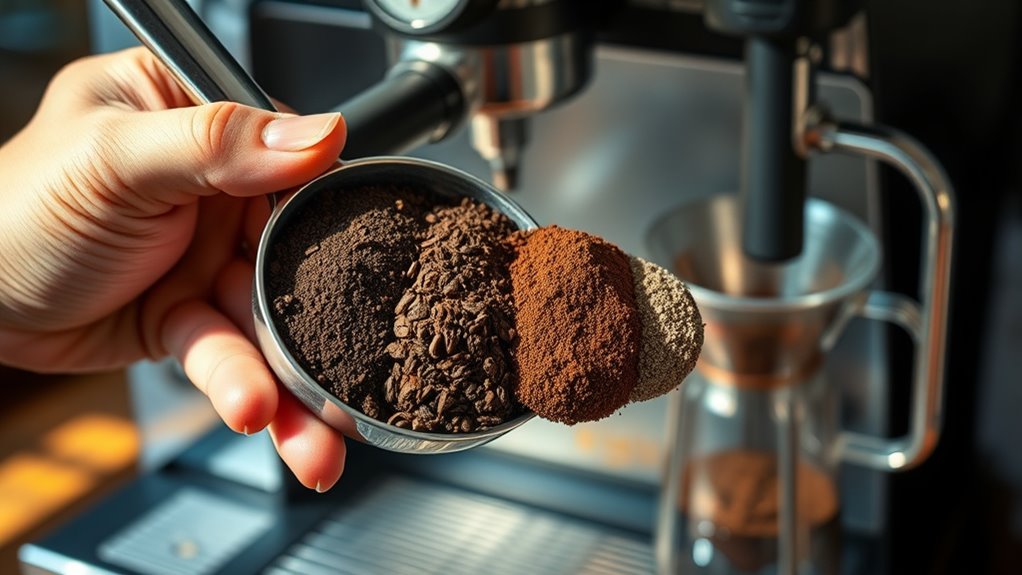
Understanding how grind size affects extraction is essential for making a great cup of coffee. When you adjust the grind size, you change the surface area exposed to water, which directly influences extraction. A finer grind increases surface area, speeding up extraction and emphasizing soluble compounds that contribute to acidity and brightness. Conversely, a coarser grind slows water flow, leading to a longer extraction time that highlights different flavor notes. Achieving a uniform grind ensures consistent flavor, while uneven particle size distribution causes over- or under-extraction. Your brewing method dictates the ideal grind size, affecting contact time and overall flavor profile. By understanding this relationship, you can control how the soluble compounds are extracted, ultimately shaping the taste and quality of your coffee. Additionally, using essential oils in your brewing process can enhance aroma and flavor, providing a more complex sensory experience. Being aware of the caffeine content can also help you tailor your brew to suit your energy needs and preferences. Moreover, selecting the appropriate grind size can optimize the functioning of various brewing equipment, leading to better extraction and flavor.
How Different Brewing Methods Require Specific Grind Sizes

Choosing the right grind size for your brewing method directly impacts how well your coffee extracts and tastes. Different brewing methods require specific grind sizes to optimize extraction rate and brew time. For filter coffee, a medium grind similar to beach sand balances clarity and speed. Espresso needs a very fine grind (~0.3mm or less) to create resistance and develop that rich crema. French press calls for a coarse grind (~0.75mm) to prevent coffee grounds from slipping through the filter and over-extracting, ensuring a smooth, full-bodied brew. AeroPress can use medium to fine grind, depending on steep time, affecting extraction rate and strength. Cold brew uses an extra-coarse grind (~1.5mm) to slow extraction over hours without bitterness. Each brewing method’s grind size influences flavor and brewing efficiency. Proper grind size ensures optimal extraction and flavor profile for each method. Additionally, understanding grind consistency can improve overall brewing results, especially when considering AI in Education to analyze brewing patterns or optimize recipes. For consistent results, it’s also important to maintain grind uniformity across batches to prevent flavor inconsistencies.
The Influence of Grind Particle Size on Coffee’s Flavor Profile
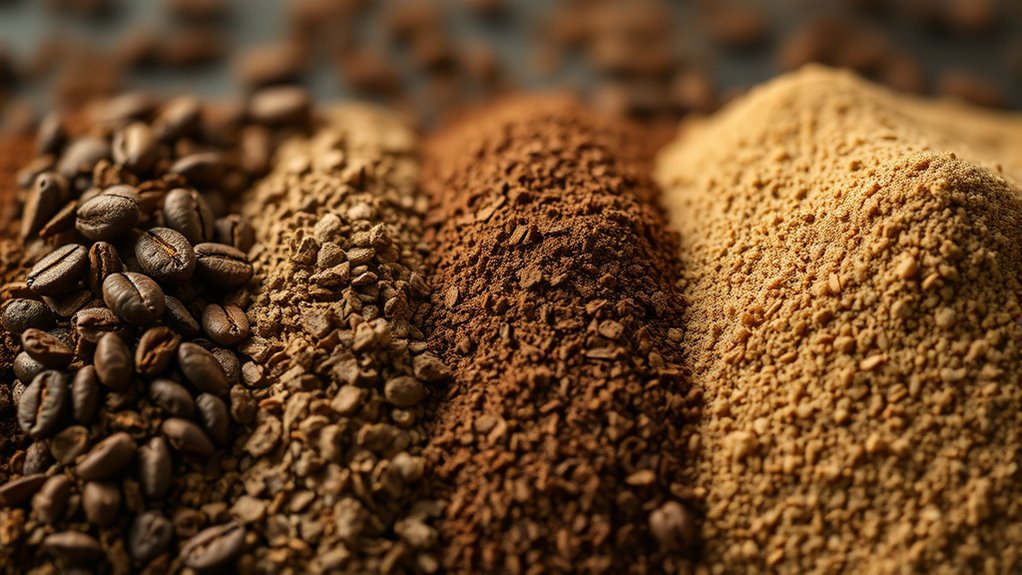
The size of coffee grind particles directly shapes the flavor profile of your brew by influencing how water interacts with the coffee grounds. Finer grinds increase surface area, leading to rapid extraction of soluble compounds and a bolder, more intense flavor. Coarser grinds slow extraction, producing a lighter, brighter cup with less bitterness. The distribution of particle sizes affects flavor clarity; uniform particles promote balanced extraction, while uneven sizes can cause over-extraction or under-extraction, leading to flavor imbalance. Fines extract quickly and can cause bitterness or clogging, whereas larger particles extract slowly, impacting mouthfeel. Particle size distribution plays a crucial role in controlling extraction rates and ensuring consistent flavor. Controlling grind size ensures the proper extraction of acids, oils, and aromatic compounds, shaping your coffee’s acidity, body, and aromatic complexity. Additionally, understanding how tuning adjustments affect your brewing process can help optimize flavor extraction and consistency. Properly managing grind uniformity can further enhance your brewing results by promoting more even extraction. For example, employing appropriate sieving techniques can help achieve a more uniform particle size, improving overall brew quality.
Visual and Scientific Ways to Measure Grind Consistency

To evaluate grind consistency effectively, you can start by visually inspecting the grounds for uniformity in particle size and color. High-quality grinders produce grounds that resemble uniform sand, indicating consistent particle size, while lower-quality grinders often create a mix of fines and boulders, showing uneven grind distribution. Visual cues like a consistent color and texture help identify grind uniformity. For more precise particle size measurement, tools like laser diffraction analyzers and particle size analyzers provide detailed data on grind distribution, often reporting the percentage of particles within specific micron ranges. Devices such as Lighttells CM-200 use optical sensors to measure particle size distribution in real-time, giving you clear insights into grind uniformity. Additionally, understanding the contrast ratio of your grinder can help optimize extraction and flavor clarity in your brewed coffee. Monitoring the particle size distribution can further enhance your brewing consistency and flavor extraction, especially when paired with grind size calibration techniques to fine-tune your process. Incorporating appliance integration features like smart controls can also allow for more consistent grind settings through automated adjustments. Regularly calibrating your grinder and understanding its performance metrics can lead to more consistent and satisfying brews.
Adjusting Grind Size to Troubleshoot and Perfect Your Coffee Brew
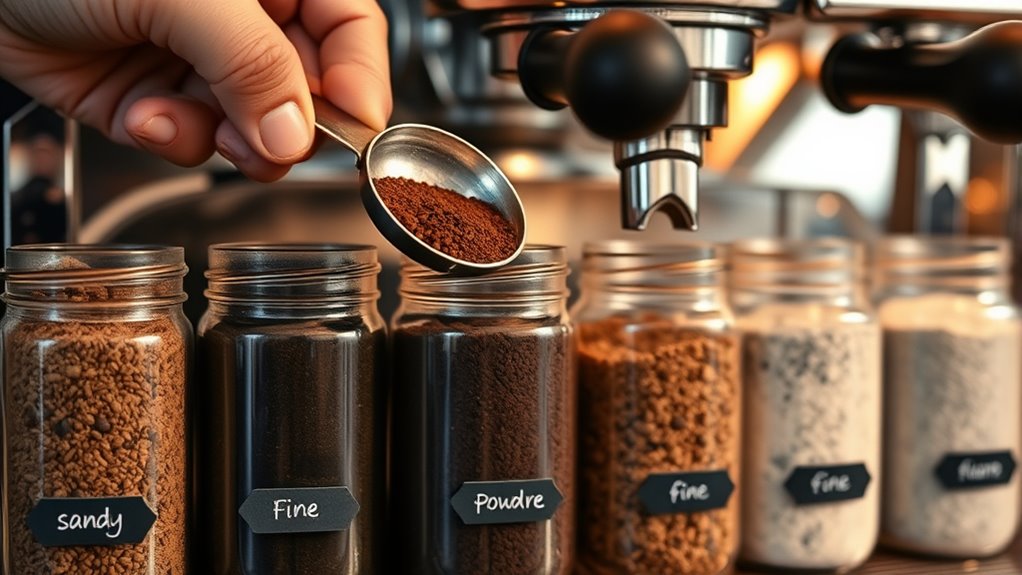
Adjusting your grind size is a practical way to troubleshoot and refine your coffee brewing process. When you change the grind size, you directly influence extraction and brew time. A finer grind increases surface area, boosting extraction and helping fix weak, under-extracted coffee. Conversely, a coarser grind reduces extraction, preventing over-extraction and bitterness. Small adjustments, like shifting from medium to medium-fine, can profoundly alter brew time and flavor balance. Using a micron measurement tool can help you fine-tune the grind to match your brew method and desired extraction rate. If your coffee tastes sour or flat, try a finer grind; if it’s bitter or harsh, coarsen the grind. Monitoring brew time alongside grind adjustments helps you troubleshoot and perfect your cup.
Frequently Asked Questions
How Does Grind Size Affect Brew Time?
You might notice that using a finer grind increases your brew time because it offers more resistance to water flow, leading to longer extraction. On the other hand, coarser grounds let water pass through faster, reducing brew time. Adjusting your grind size helps you fine-tune your extraction and flavor. By paying attention to brew time, you can achieve a consistent, balanced cup tailored to your preferred strength and clarity.
What Is the 15-15-15 Coffee Rule?
Imagine tuning a guitar; each string’s tension changes the sound. The 15-15-15 coffee rule is like that, guiding you to use 15 grams of coffee, 15 grams of water, and a 15-second brew time. It’s a simple starting point to test and adjust your grind size for ideal flavor. Think of it as a quick tune-up to find the perfect balance between strength and clarity in your brew.
What Is the Best Grind Size for Brewed Coffee?
The best grind size for brewed coffee depends on your brewing method. For drip coffee or pour-overs, aim for a medium grind like beach sand to guarantee proper extraction. If you’re using a French press, go coarser, and for espresso, choose a fine, powdery grind. Adjusting your grind slightly can help fix sour or bitter flavors, helping you get the perfect cup every time.
What Happens if the Grind Size Is Too Fine?
When the grind size is too fine, you’re asking for trouble. Water faces too much resistance, making your brew take forever and risking over-extraction. It can clog filters, cause uneven extraction, and produce a thick, gritty cup with a bitter, harsh taste. Plus, the fine grounds generate extra heat, degrading aromatics and dulling flavors. Basically, you’re fighting an uphill battle with a grind that’s too fine.
Conclusion
Getting your grind size just right is like tuning a musical instrument—you’ll notice the difference in flavor and clarity. Whether you’re using a French press or an espresso machine, adjusting the grind can reveal the full potential of your beans. Don’t be afraid to experiment and fine-tune your settings. Remember, small changes are like tiny brushstrokes on a masterpiece—they can make your coffee taste perfectly balanced and incredibly satisfying.
